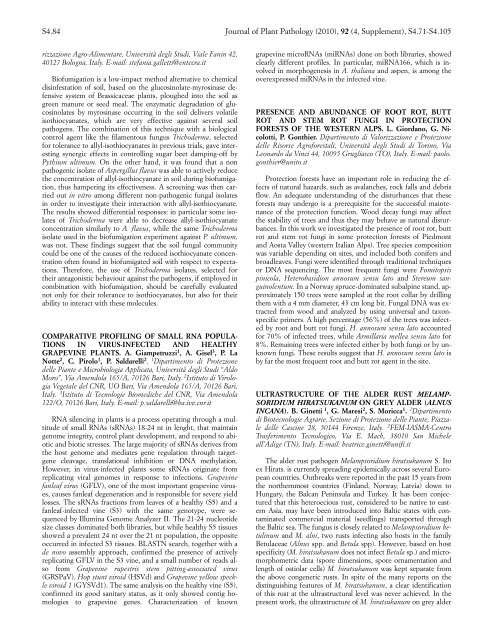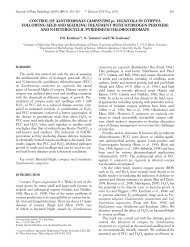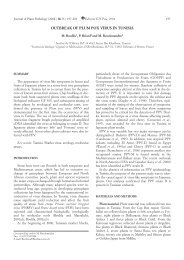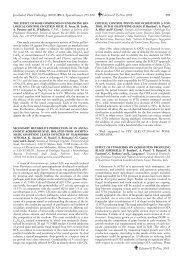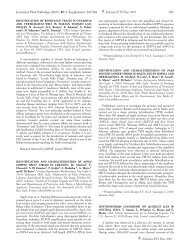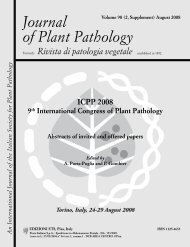Journal of Plant Pathology (2010), 92 (4, Supplement ... - Sipav.org
Journal of Plant Pathology (2010), 92 (4, Supplement ... - Sipav.org
Journal of Plant Pathology (2010), 92 (4, Supplement ... - Sipav.org
Create successful ePaper yourself
Turn your PDF publications into a flip-book with our unique Google optimized e-Paper software.
S4.84 <strong>Journal</strong> <strong>of</strong> <strong>Plant</strong> <strong>Pathology</strong> (<strong>2010</strong>), <strong>92</strong> (4, <strong>Supplement</strong>), S4.71-S4.105<br />
rizzazione Agro-Alimentare, Università degli Studi, Viale Fanin 42,<br />
40127 Bologna, Italy. E-mail: stefania.galletti@entecra.it<br />
Bi<strong>of</strong>umigation is a low-impact method alternative to chemical<br />
disinfestation <strong>of</strong> soil, based on the glucosinolate-myrosinase defensive<br />
system <strong>of</strong> Brassicaceae plants, ploughed into the soil as<br />
green manure or seed meal. The enzymatic degradation <strong>of</strong> glucosinolates<br />
by myrosinase occurring in the soil delivers volatile<br />
isothiocyanates, which are very effective against several soil<br />
pathogens. The combination <strong>of</strong> this technique with a biological<br />
control agent like the filamentous fungus Trichoderma, selected<br />
for tolerance to allyl-isothiocyanates in previous trials, gave interesting<br />
synergic effects in controlling sugar beet damping-<strong>of</strong>f by<br />
Pythium ultimum. On the other hand, it was found that a non<br />
pathogenic isolate <strong>of</strong> Aspergillus flavus was able to actively reduce<br />
the concentration <strong>of</strong> allyl-isothiocyanate in soil during bi<strong>of</strong>umigation,<br />
thus hampering its effectiveness. A screening was then carried<br />
out in vitro among different non-pathogenic fungal isolates<br />
in order to investigate their interaction with allyl-isothiocyanate.<br />
The results showed differential responses: in particular some isolates<br />
<strong>of</strong> Trichoderma were able to decrease allyl-isothiocyanate<br />
concentration similarly to A. flavus, while the same Trichoderma<br />
isolate used in the bi<strong>of</strong>umigation experiment against P. ultimum,<br />
was not. These findings suggest that the soil fungal community<br />
could be one <strong>of</strong> the causes <strong>of</strong> the reduced isothiocyanate concentration<br />
<strong>of</strong>ten found in bi<strong>of</strong>umigated soil with respect to expectations.<br />
Therefore, the use <strong>of</strong> Trichoderma isolates, selected for<br />
their antagonistic behaviour against the pathogens, if employed in<br />
combination with bi<strong>of</strong>umigation, should be carefully evaluated<br />
not only for their tolerance to isothiocyanates, but also for their<br />
ability to interact with these molecules.<br />
COMPARATIVE PROFILING OF SMALL RNA POPULA-<br />
TIONS IN VIRUS-INFECTED AND HEALTHY<br />
GRAPEVINE PLANTS. A. Giampetruzzi 1 , A. Gisel 3 , P. La<br />
Notte 2 , C. Pirolo 1 , P. Saldarelli 2 . 1 Dipartimento di Protezione<br />
delle Piante e Microbiologia Applicata, Università degli Studi “Aldo<br />
Moro”, Via Amendola 165/A, 70126 Bari, Italy. 2 Istituto di Virologia<br />
Vegetale del CNR, UO Bari, Via Amendola 165/A, 70126 Bari,<br />
Italy. 3 Istituto di Tecnologie Biomediche del CNR, Via Amendola<br />
122/O, 70126 Bari, Italy. E-mail: p.saldarelli@ba.ivv.cnr.it<br />
RNA silencing in plants is a process operating through a multitude<br />
<strong>of</strong> small RNAs (sRNAs) 18-24 nt in lenght, that maintain<br />
genome integrity, control plant development, and respond to abiotic<br />
and biotic stresses. The large majority <strong>of</strong> sRNAs derives from<br />
the host genome and mediates gene regulation through targetgene<br />
cleavage, translational inhibition or DNA methylation.<br />
However, in virus-infected plants some sRNAs originate from<br />
replicating viral genomes in response to infections. Grapevine<br />
fanleaf virus (GFLV), one <strong>of</strong> the most important grapevine viruses,<br />
causes fanleaf degeneration and is responsible for severe yield<br />
losses. The sRNAs fractions from leaves <strong>of</strong> a healthy (S5) and a<br />
fanleaf-infected vine (S3) with the same genotype, were sequenced<br />
by Illumina Genome Analyzer II. The 21-24 nucleotide<br />
size classes dominated both libraries, but while healthy S5 tissues<br />
showed a prevalent 24 nt over the 21 nt population, the opposite<br />
occurred in infected S3 tissues. BLASTN search, together with a<br />
de novo assembly approach, confirmed the presence <strong>of</strong> actively<br />
replicating GFLV in the S3 vine, and a small number <strong>of</strong> reads also<br />
from Grapevine rupestris stem pitting-associated virus<br />
(GRSPaV), Hop stunt viroid (HSVd) and Grapevine yellow speckle<br />
viroid 1 (GYSVd1). The same analysis on the healthy vine (S5),<br />
confirmed its good sanitary status, as it only showed contig homologies<br />
to grapevine genes. Characterization <strong>of</strong> known<br />
grapevine microRNAs (miRNAs) done on both libraries, showed<br />
clearly different pr<strong>of</strong>iles. In particular, miRNA166, which is involved<br />
in morphogenesis in A. thaliana and aspen, is among the<br />
overexpressed miRNAs in the infected vine.<br />
PRESENCE AND ABUNDANCE OF ROOT ROT, BUTT<br />
ROT AND STEM ROT FUNGI IN PROTECTION<br />
FORESTS OF THE WESTERN ALPS. L. Giordano, G. Nicolotti,<br />
P. Gonthier. Dipartimento di Valorizzazione e Protezione<br />
delle Risorse Agr<strong>of</strong>orestali, Università degli Studi di Torino, Via<br />
Leonardo da Vinci 44, 10095 Grugliasco (TO), Italy. E-mail: paolo.<br />
gonthier@unito.it<br />
Protection forests have an important role in reducing the effects<br />
<strong>of</strong> natural hazards, such as avalanches, rock falls and debris<br />
flow. An adequate understanding <strong>of</strong> the disturbances that these<br />
forests may undergo is a prerequisite for the successful maintenance<br />
<strong>of</strong> the protection function. Wood decay fungi may affect<br />
the stability <strong>of</strong> trees and thus they may behave as natural disturbances.<br />
In this work we investigated the presence <strong>of</strong> root rot, butt<br />
rot and stem rot fungi in some protection forests <strong>of</strong> Piedmont<br />
and Aosta Valley (western Italian Alps). Tree species composition<br />
was variable depending on sites, and included both conifers and<br />
broadleaves. Fungi were identified through traditional techniques<br />
or DNA sequencing. The most frequent fungi were Fomitopsis<br />
pinicola, Heterobasidion annosum sensu lato and Stereum sanguinolentum.<br />
In a Norway spruce-dominated subalpine stand, approximately<br />
150 trees were sampled at the root collar by drilling<br />
them with a 4 mm diameter, 43 cm long bit. Fungal DNA was extracted<br />
from wood and analyzed by using universal and taxonspecific<br />
primers. A high percentage (56%) <strong>of</strong> the trees was infected<br />
by root and butt rot fungi. H. annosum sensu lato accounted<br />
for 70% <strong>of</strong> infected trees, while Armillaria mellea sensu lato for<br />
8%. Remaining trees were infected either by both fungi or by unknown<br />
fungi. These results suggest that H. annosum sensu lato is<br />
by far the most frequent root and butt rot agent in the site.<br />
ULTRASTRUCTURE OF THE ALDER RUST MELAMP-<br />
SORIDIUM HIRATSUKANUM ON GREY ALDER (ALNUS<br />
INCANA). B. Ginetti 1 , G. Maresi 2 , S. Moricca 1 . 1 Dipartimento<br />
di Biotecnologie Agrarie, Sezione di Protezione delle Piante, Piazzale<br />
delle Cascine 28, 50144 Firenze, Italy. 2 FEM-IASMA-Centro<br />
Trasferimento Tecnologico, Via E. Mach, 38010 San Michele<br />
all’Adige (TN), Italy. E-mail: beatrice.ginetti@unifi.it<br />
The alder rust pathogen Melampsoridium hiratsukanum S. Ito<br />
ex Hirats. is currently spreading epidemically across several European<br />
countries. Outbreaks were reported in the past 15 years from<br />
the northernmost countries (Finland, Norway, Latvia) down to<br />
Hungary, the Balcan Peninsula and Turkey. It has been conjectured<br />
that this heteroecious rust, considered to be native to eastern<br />
Asia, may have been introduced into Baltic states with contaminated<br />
commercial material (seedlings) transported through<br />
the Baltic sea. The fungus is closely related to Melampsoridium betulinum<br />
and M. alni, two rusts infecting also hosts in the family<br />
Betulaceae (Alnus spp. and Betula spp). However, based on host<br />
specificity (M. hiratsukanum does not infect Betula sp.) and micromorphometric<br />
data (spore dimensions, spore ornamentation and<br />
length <strong>of</strong> ostiolar cells) M. hiratsukanum was kept separate from<br />
the above congeneric rusts. In spite <strong>of</strong> the many reports on the<br />
distinguishing features <strong>of</strong> M. hiratsukanum, a clear identification<br />
<strong>of</strong> this rust at the ultrastructural level was never achieved. In the<br />
present work, the ultrastructure <strong>of</strong> M. hiratsukanum on grey alder


